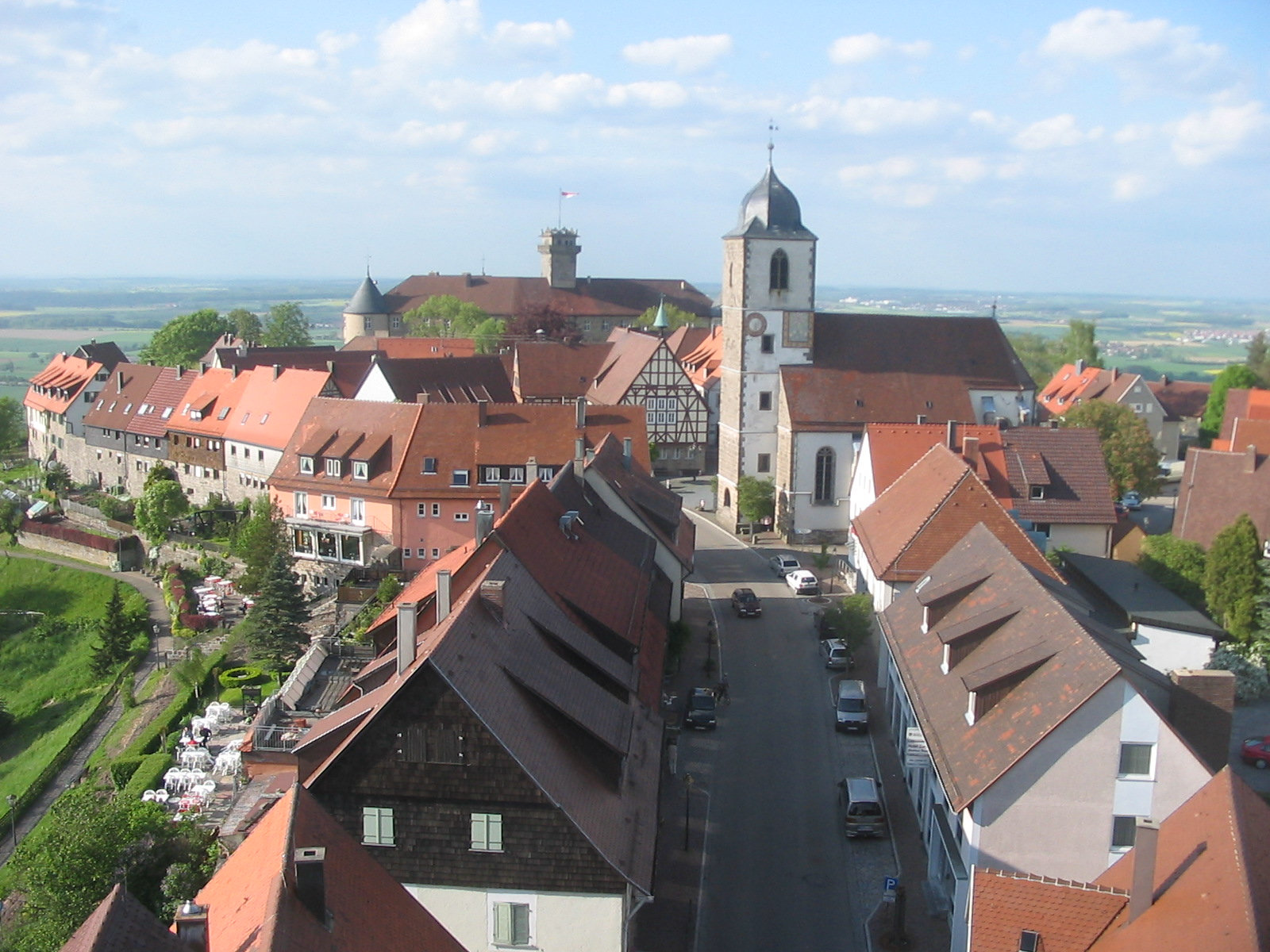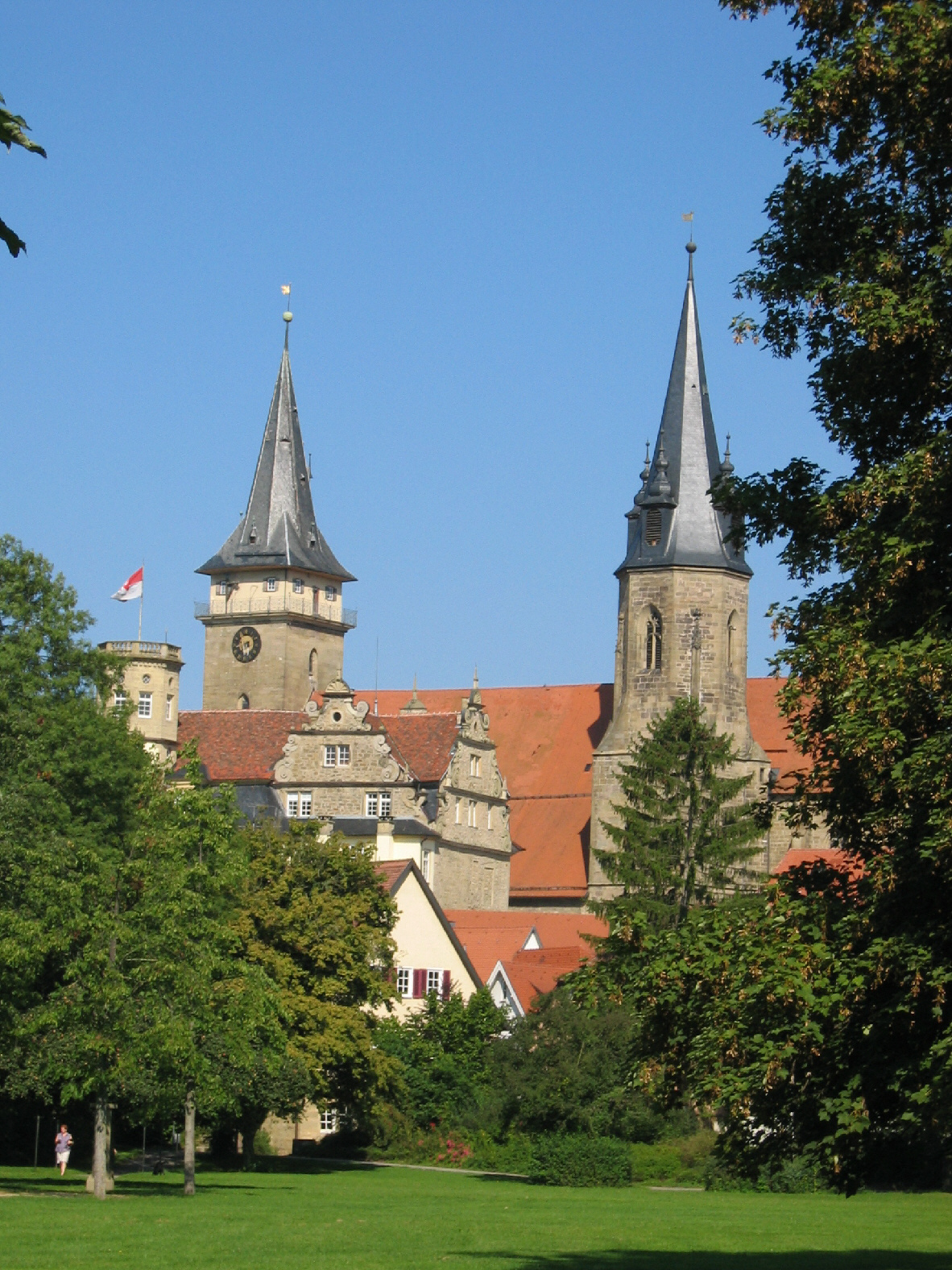|
Schloss Neuenstein
Neuenstein Castle (german: Schloss Neuenstein) is a schloss, castle in the middle of the town of Neuenstein, Baden-Württemberg, Neuenstein. Built as the seat of the Hohenlohe-Neuenstein noble family, it now houses a castle museum and, with the Neuenstein Hohenlohe Central Archives, the shared house archive of the House of Hohenlohe, which is looked after by the State of Baden-Württemberg. History The origins of the present castle can be found in a Hohenstaufen moated castle from the early 13th century. It stood on a sandbank in a swampy area near an old long-distance trade route that led from the Rhine via Bad Wimpfen, Wimpfen east to the Danube. Around 1230, the complex was owned by the Lords of Stein, whose descendants later called themselves "von Neuenstein". Around 1300, the Neuenstein estate came to the House of Hohenlohe, which still owns the castle today. Gottfried von Hohenlohe, who lived at Weikersheim Castle, was a follower of Holy Roman Emperor, Emperor Frederick II, ... [...More Info...] [...Related Items...] OR: [Wikipedia] [Google] [Baidu] |
Frederick II, Holy Roman Emperor
Frederick II (German language, German: ''Friedrich''; Italian language, Italian: ''Federico''; Latin: ''Federicus''; 26 December 1194 – 13 December 1250) was King of Sicily from 1198, King of Germany from 1212, King of Italy and Holy Roman Emperor from 1220 and King of Jerusalem from 1225. He was the son of emperor Henry VI, Holy Roman Emperor, Henry VI of the House of Hohenstaufen, Hohenstaufen dynasty and Queen Constance, Queen of Sicily, Constance of Sicily of the Hauteville family, Hauteville dynasty. His political and cultural ambitions were enormous as he ruled a vast area, beginning with Sicily and stretching through Italy all the way north to Germany. As the Crusades progressed, he acquired control of Jerusalem and styled himself its king. However, the Papacy became his enemy, and it eventually prevailed. Viewing himself as a direct successor to the Roman emperors of antiquity, he was Holy Roman Emperor, Emperor of the Romans from his papal coronation in 1220 until hi ... [...More Info...] [...Related Items...] OR: [Wikipedia] [Google] [Baidu] |
Waldenburg, Baden-Württemberg
Waldenburg is a hilltop town in south central Germany, eastwards of Heilbronn in the Hohenlohe (district) of Baden-Württemberg. The town is the site of Waldenburg Castle and some hilltop churches. Records first mention Waldenburg in the year 1253, but the town was destroyed in April 1945, at the end of World War II, and it has been rebuilt since. Geography Geographical form Waldenburg covers part of the natural Schwäbisch-Fränkische forest-hills and the Hohenloher-Haller Ebene. City outline Waldenburg includes the village of Waldenburg proper and the 2 sections Obersteinbach (173 people, as of 31 March 2006) and Sailach (222 people). History of Waldenburg dates from 1253. By 1330 it was a free city. Plague and war reduced the population during the Thirty Years' War. The Confederation of the Rhine of 1806 annexed Waldenburg into the Kingdom of Württemberg under the process of "mediatisation", and the town has been part of the Federal Republic of Germany state of Baden ... [...More Info...] [...Related Items...] OR: [Wikipedia] [Google] [Baidu] |
Illerkirchberg
Illerkirchberg is a town in the district of Alb-Donau in Baden-Württemberg in Germany. Unterkirchberg (Lower Kirchberg) had a Roman castrum built around 40 AD as part of the Upper Germanic-Rhaetian Limes to secure the street along the south shore of the Danube. Oberkirchberg (Upper Kirchberg) was mentioned in 1087 as seat of the counts of Kirchberg who extinguished in 1519. By then, the county had already been sold to Bavaria and then to Austria. It was finally sold by Emperor Maximilian I. to Jakob Fugger in 1507, together with the adjacent lordships Weißenhorn, Wullenstetten and Pfaffenhofen (Roth), for 50.000 guilders. Schmiechen followed in 1508 and the lordship Biberbach in 1514. The emperor granted him the title of Imperial Count in 1514 so the former burgher could operate his business without interference from local nobility.Häberlein 2006, p. 188Pölnitz 1999, p. 112 In the course of his life Jakob Fugger also became lord of more than 50 smaller villages. A new cas ... [...More Info...] [...Related Items...] OR: [Wikipedia] [Google] [Baidu] |
Ingelfingen
Ingelfingen is a town in the Hohenlohe district, in Baden-Württemberg, Germany. It is situated on the river Kocher, 4 km northwest of Künzelsau, and 36 km northeast of Heilbronn. Twin towns Ingelfingen is twinned with: * Saint-Héand, France, since 1991 Sons and daughters of the place * Frederick Louis, Prince of Hohenlohe-Ingelfingen Frederick Louis, Prince of Hohenlohe-Ingelfingen (german: Friedrich Ludwig Fürst zu Hohenlohe-Ingelfingen) (31 January 1746 – 15 February 1818) was a Prussian general. Early life Frederick Louis was the eldest son of Henry August, Princ ... (1747-1818), Prussian general and Hohenlohe prince * Friedrich Karl Wilhelm, Fürst zu Hohenlohe (1752-1815), Field Marshal Lieutenant, Prince of Hohenlohe-Ingelfingen References Hohenlohe (district) Württemberg {{Hohenlohe-geo-stub ... [...More Info...] [...Related Items...] OR: [Wikipedia] [Google] [Baidu] |
Langenburg
Langenburg () is a town in the district of Schwäbisch Hall, in Baden-Württemberg, Germany. It is located on a hill above the river Jagst, 18 km northeast of Schwäbisch Hall. It is also the place where Wibele - small, sweet, biscuit-like pastries - were invented and are still baked today. History The history of Langenburg begins with the building of a castle on the western hill crag. Prehistoric settling is likely, but not proven. Langenburg is first documented in 1226. The free Lords of Langenburg, which stepped into history in 1201, were closely related to the Lords of Hohenlohe. Maybe they even held family bonds. After the Langenburgs had died out, the Hohenlohe family inherited the possessions. Langenburg thus came under the rule of Hohenlohe and remained part of the Principality for the next centuries. Since 1568 Langenburg was the residency of the county and latter principality Hohenlohe-Langenburg. In the 17th Century, Langenburg was the site of witch trials. Th ... [...More Info...] [...Related Items...] OR: [Wikipedia] [Google] [Baidu] |
Louis Casimir, Count Of Hohenlohe-Neuenstein , names sometimes translated to English as "Louis"
{{disamb ...
Louis may refer to: * Louis (coin) * Louis (given name), origin and several individuals with this name * Louis (surname) * Louis (singer), Serbian singer * HMS ''Louis'', two ships of the Royal Navy See also Derived or associated terms * Lewis (other) * Louie (other) * Luis (other) * Louise (other) * Louisville (other) * Louis Cruise Lines * Louis dressing, for salad * Louis Quinze, design style Associated names * * Chlodwig, the origin of the name Ludwig, which is translated to English as "Louis" * Ladislav and László - names sometimes erroneously associated with "Louis" * Ludovic, Ludwig, Ludwick, Ludwik Ludwik () is a Polish given name. Notable people with the name include: * Ludwik Czyżewski, Polish WWII general * Ludwik Fleck (1896–1961), Polish medical doctor and biologist * Ludwik Gintel (1899–1973), Polish-Israeli Olympic soccer player ... [...More Info...] [...Related Items...] OR: [Wikipedia] [Google] [Baidu] |
Öhringen
Öhringen (East Franconian: ''Ähringe'') is the largest town in Hohenlohe (district) in the state of Baden-Württemberg, in southwest Germany, near Heilbronn. Öhringen is on the railline to Schwäbisch Hall and Crailsheim. With a population of 24,374 (2019), the town is diverse. It is a quaint medieval place, and, among its ancient buildings, boasts a fine Evangelical church (german: Stiftskirche) containing carvings in cedar-wood from the 15th century and numerous interesting tombs and monuments; a Renaissance town hall; the building, now used as a library, which formerly belonged to a monastery, erected in 1034; and a palace, the former residence of the princes of Hohenlohe-Öhringen. ''Vicus Aurelii'' to the Romans. Eastwards of it runs the old limes Roman frontier wall, and numerous remains and inscriptions dating from the days of the Roman settlement have been discovered, including traces of three camps. Geography Geographical location Öhringen is located in the wes ... [...More Info...] [...Related Items...] OR: [Wikipedia] [Google] [Baidu] |
Bailiwick
A bailiwick () is usually the area of jurisdiction of a bailiff, and once also applied to territories in which a privately appointed bailiff exercised the sheriff's functions under a royal or imperial writ. The bailiwick is probably modelled on the administrative organization which was attempted for a very small time in Sicily and has its roots in the official state of the Hohenstaufen. In English, the original French ''bailie'' combined with '-wic', the Anglo-Saxon suffix (meaning a village) to produce a term meaning literally 'bailiff's village'—the original geographic scope of a bailiwick. In the 19th century, it was absorbed into American English as a metaphor for a sphere of knowledge or activity. The term survives in administrative usage in the British Crown Dependencies of the Channel Islands, which are grouped for administrative purposes into two bailiwicks — the Bailiwick of Jersey (comprising the island of Jersey and uninhabited islets such as the Minquiers ... [...More Info...] [...Related Items...] OR: [Wikipedia] [Google] [Baidu] |
Fiefdom
A fief (; la, feudum) was a central element in medieval contracts based on feudal law. It consisted of a form of property holding or other rights granted by an overlord to a vassal, who held it in fealty or "in fee" in return for a form of feudal allegiance, services and/or payments. The fees were often lands, land revenue or revenue-producing real property like a watermill, held in feudal land tenure: these are typically known as fiefs or fiefdoms. However, not only land but anything of value could be held in fee, including governmental office, rights of exploitation such as hunting, fishing or felling trees, monopolies in trade, money rents and tax farms. There never did exist one feudal system, nor did there exist one type of fief. Over the ages, depending on the region, there was a broad variety of customs using the same basic legal principles in many variations. Terminology In ancient Rome, a " benefice" (from the Latin noun , meaning "benefit") was a gift of land ... [...More Info...] [...Related Items...] OR: [Wikipedia] [Google] [Baidu] |
Bishop Of Regensburg
The Bishops of Regensburg (Ratisbon) are bishops of the Roman Catholic Diocese of Regensburg, Bavaria, Germany."Diocese of Regensburg" ''''. David M. Cheney. Retrieved February 29, 2016"Diocese of Regensburg" ''GCatholic.org''. Gabriel Chow. Retrieved February 29, 2016 The seat of the bishops is . History Th ...[...More Info...] [...Related Items...] OR: [Wikipedia] [Google] [Baidu] |




